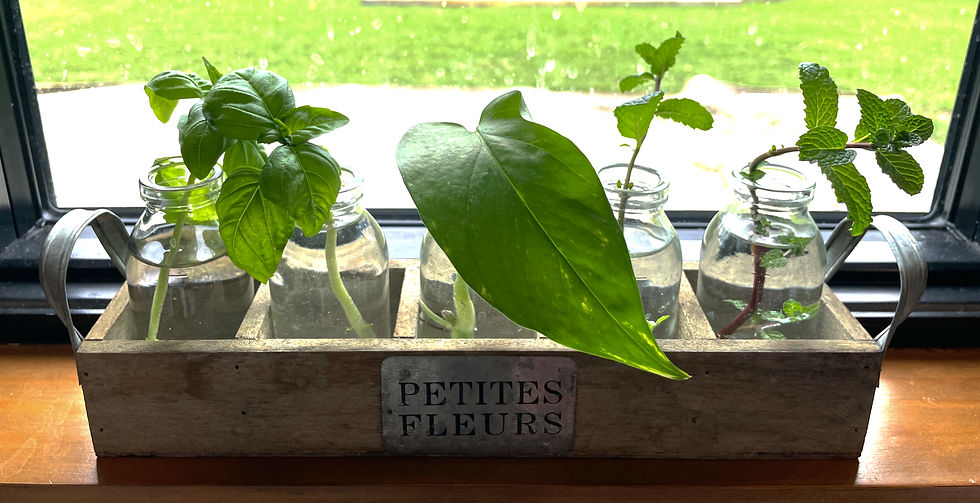DIY Propagating Plants in Water Indoors
- Angela Kuchenbecker
- Apr 25
- 5 min read
Hey there! If you're a plant lover, you might find propagating plants in water to be a really fun and satisfying way to expand your indoor garden. It’s a fantastic method that not only helps you grow new plants, but also adds a lovely decorative touch to your home.
Understanding Plant Propagation
So, what exactly is plant propagation? It’s all about creating new plants from existing ones. There are a few different methods to do this, like seed propagation, division, and cutting. Water propagation is a specific technique where you take cuttings from a parent plant and place them in water until they develop roots. Many houseplants, such as pothos, philodendrons, and spider plants, are perfect candidates for this method.

Indoor Plants
Not every plant will thrive in water, but there are plenty of popular houseplants that do great! Here are some excellent options:
Pothos (Epipremnum aureum): This plant is a favorite because of its trailing vines and heart-shaped leaves. Plus, it’s super forgiving and roots easily in water.
Philodendron: Many types of philodendrons can be propagated through cuttings, making them a go-to for indoor gardeners.
Spider Plant (Chlorophytum comosum): Known for producing "babies," spider plants can be cut and placed in water to grow new roots.
Coleus: With its vibrant foliage, coleus is another great option for water propagation, adding a pop of color to your indoor garden.
Step-by-Step Guide to Water Propagation for Indoor Plants
Ready to get started? Here’s a simple step-by-step guide:
Select Healthy Cuttings: Begin by choosing a healthy parent plant. Look for stems that are free from pests and diseases. Using clean, sharp scissors or pruning shears, take a cutting that’s about 4 to 6 inches long, making sure it has a couple of leaves.
Prepare the Cuttings: Remove any leaves that will be submerged in water to prevent rot. This is super important, as decaying leaves can cause bacterial growth and harm your cutting.
Place in Water: Fill a clear glass or jar with clean, room-temperature water. Place the cutting in the water, ensuring the cut end is submerged while the leaves stay above the surface. A clear container lets you easily monitor root development.
Provide Proper Conditions: Position the container in a spot that gets indirect sunlight. Too much direct sunlight can heat the water and damage the cutting, while too little light can slow down root growth. A windowsill with filtered light is usually perfect.
Change the Water Regularly: To keep the water fresh and oxygenated, change it every few days. This helps prevent algae growth and keeps your cutting healthy. Don’t forget to rinse the container occasionally to remove any debris!
Wait for Roots to Develop: Depending on the plant species and conditions, roots may take anywhere from a few days to several weeks to develop. They’re ready when they’re about 2 inches long.
Transplanting (Optional): Once the roots are well-established, you can either keep the plant in water or transplant it into soil. If you choose to move it to soil, pick a pot with good drainage and quality potting mix. Gently remove the cutting from the water, being careful not to damage the roots, and plant it in the soil.

Basil, Pothos and Mint
Propagating Mint, Basil and Lettuce
Mint
To propagate mint in water, begin by selecting a healthy stem from an existing mint plant. Ideally, the cutting should be around 4 to 6 inches long and should include several leaves. Make a clean cut just below a node, which is the part of the stem where leaves emerge.
Once you have your cutting, remove the lower leaves to prevent them from rotting once submerged in water. Place the cutting in a glass or jar filled with clean, room-temperature water, ensuring that the node is submerged while the leaves remain above the waterline. Position the container in a location that receives indirect sunlight, as direct sunlight can cause the water to heat up and harm the cutting.
Change the water every few days to keep it fresh and to prevent any bacterial growth. Within a week or two, you should start to see roots developing from the node. Once the roots are about 2 to 3 inches long, you can transplant the mint cutting into a pot with soil if you desire, or you can continue to grow it in water for an extended period.
Basil
Basil is another herb that thrives in water propagation. Similar to mint, start by selecting a healthy basil stem. Cut a 4 to 6-inch piece just below a node, and remove the lower leaves to avoid decay in the water. Place the cutting in a glass of water, ensuring the node is submerged. Basil prefers bright, indirect sunlight, so find a suitable spot in your home where it can receive adequate light without being scorched.
Like with mint, it is important to change the water regularly, ideally every few days, to keep the environment healthy for root growth. You can expect to see roots developing within one to two weeks. Once the roots are established, you can either keep the basil in water or transfer it to a pot with soil, where it can continue to grow and flourish.
Lettuce
Green leaf lettuce can also be propagated in water, although it is generally more common to grow it from seeds. To propagate lettuce, take the base of a head of lettuce that you have purchased from the store. Cut off about 2 inches from the bottom of the lettuce head, ensuring that the core is intact.
Place the cut end in a shallow dish of water, ensuring that the water covers the base but does not submerge the entire head. Position the dish in a well-lit area, preferably with indirect sunlight. Change the water daily to keep it fresh and to promote healthy growth.
Within a few days, you should begin to observe new leaves sprouting from the center of the lettuce head. After about a week, small roots will start to develop at the bottom. Once the roots are about 2 to 3 inches long, you can transplant the lettuce into soil for a more sustainable growth option. Alternatively, you can continue to grow it in water, although this may limit the size of the plant.
Benefits of Water Propagation
Why should you try water propagation? Here are a few benefits:
Visual Appeal: Watching roots grow in water can be fascinating, and clear containers can serve as beautiful decor in any room.
Ease of Care: Water propagation often requires less maintenance than soil propagation, as you don’t have to constantly monitor soil moisture levels.
Pest Control: Growing plants in water can help reduce the chances of soil-borne pests and diseases.
Conclusion
DIY propagating plants in water indoors is a simple yet fulfilling hobby that can beautify your living space while expanding your plant collection. By selecting suitable plants, following the right techniques, and providing the ideal conditions, you’ll enjoy the satisfaction of watching new roots develop and thrive. Whether you keep your new plants in water or eventually transfer them to soil, the journey of propagation is sure to enhance your indoor gardening experience!






Comments